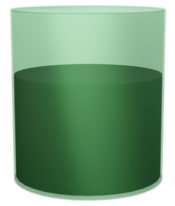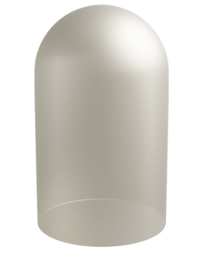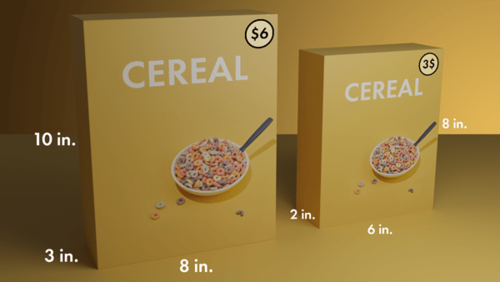Sign In
Modeling in Three Dimensions







| | 8 Theory slides |
| | 9 Exercises - Grade E - A |
| | Each lesson is meant to take 1-2 classroom sessions |
Catch-Up and Review
Here are a few recommended readings before getting started with this lesson.
Comparing Aquarium Volumes

Comparing Aquarium Volumes II
Recall how the formula for the volume of a sphere is proven. The same thought process used in the proof can be applied to solve the challenge.
Two types of aquariums attract the attention of Dominica: Aquarium A and Aquarium B.

Hint
Solution
| Volume of the Cylinder | Volume of the Cone | |
|---|---|---|
| Formula | V1=πr2h | V2=31πr2h |
Both the cone and the cylinder forming Aquarium A have a 10 foot diameter, and therefore both have a radius of 5 feet. With that in mind, substitute r=5 and h=5.
| Volume of the Cylinder | Volume of the Cone | |
|---|---|---|
| Formula | V1=πr2h | V2=31πr2h |
| Substitute Values | V1=π(5)25 | V2=31π(5)25 |
| Calculate | V1=125π | V2=3125π |
V1=125π, V2=3125π
a=33⋅a
Subtract fractions
Use a calculator
Round to nearest integer
Aquarium A
Since the cone inside the aquarium is a right cone, its vertex is directly above the center of its base. Furthermore, its height and radius have the same length. Therefore, an isosceles right triangle inside the cone can be formed, as indicated in the diagram.

Substitute values
Calculate power
Commutative Property of Multiplication
(a−b)2=a2−2ab+b2
Distribute -π
Subtract term
Aquarium B
Examine the vertical cross-sections of the hemisphere.
AB=5−h, AC=5
LHS−(5−h)2=RHS−(5−h)2
Calculate power
(a−b)2=a2−2ab+b2
Distribute -1
Subtract term
LHS=RHS
a2=a

|
Cavalieri Principle |
|
Two solids with the same height and the same cross-sectional area at every altitude have the same volume. |
Both aquariums have a height of 5 feet, and the area of the water’s surface when filled to a height of h feet is the same for each aquarium.
| Aquarium A | Aquarium B | |
|---|---|---|
| Height (ft) | 5 | |
| Cross-Sectional Area (ft2) | 10πh−πh2 | |
Finding the Length of a Toilet Paper Roll
Tiffaniqua wants to calculate the length of the a toilet paper roll. Hey! It is on a great sale, Okay. She draws a diagram and denotes the thickness of the paper, the inner radius, and the outer radius by t, r, and R, respectively.

Solution


Cylindrical Soda Can
A cylindrical soda can is made of aluminum. It is 6 inches high and its bases have a radius of approximately 1.2 inches.

Give a go at answering the following set of questions. If necessary, round the answer to two decimal places.
Hint
Solution
a⋅cb=ca⋅b
Cross out common factors
Simplify quotient
Multiply
Choosing Type of Glass
By modeling real-life objects using geometric shapes, various characteristics of the objects can be determined. These characteristics can then be compared to make inferences which could impact real decisions to be made.
Emily is attending a fair and wants to sell 1.5 liters of homemade orange juice she is naming Oranjya Thirsty. She needs to decide the type of glass she will use to serve the juice — a cocktail glass or a Collins glass.

A cocktail glass is a type of glass that has an inverted cone bowl. The cone bowl's height is 5.8 centimeters and the radius of its base is 5.4 centimeters. A collins glass is a cylindrical glass with a height of 9 centimeters and a radius of 3.2 centimeters. Help Emily make a decision by answering the following questions.
Hint
Solution

r=5.4, h=5.8
Calculate power
Multiply
b1⋅a=ba
Use a calculator
Round to nearest integer

| Type of Glass | |
|---|---|
| Cocktail Glass | Collins Glass |
| 8⋅6 | 5⋅10 |
| $48 | $50 |
Estimating How Many Grains of Sand a Hand Can Hold
Take, for example, Ramsha's situation. She is looking through photos from her trip to the beach to post on her social media page. A photo that shows her holding sand sparks her curiosity. She wonders how many individual grains of sand is she holding. Ramsha thinks she can model a grain of sand using a sphere. She then assumes that each grain has a diameter of 0.06 centimeters.

Answer
About 1.7×106
Hint
The formula for the volume of a sphere is V=34πr3, where r is the radius of the sphere.
Solution
Finding the Volume of a Grain
The radius of a grain is 20.06=0.03 centimeters. Use the formula for the volume of a sphere to find the volume of a grain.r=0.03
Calculate power
Commutative Property of Multiplication
ca⋅b=ca⋅b
Use a calculator
Round to 5 decimal place(s)
Write in scientific notation
Finding the Mass of a Grain
The density of a grain is 1.52g/cm3 and its volume is 1.1×10-4 cubic centimeters. By multiplying these values, the mass of a grain can be found.ca⋅b=ca⋅b
Cancel out common factors
Simplify quotient
Commutative Property of Multiplication
Multiply
Round to 1 decimal place(s)
Finding the Number of Grains
Finally, substitute the values into the formula mentioned at the beginning to calculate the number of grains of sand.M=300g, m=1.7×10-4g
Cross out common factors
Simplify quotient
Write as a product of fractions
am1=a-m
Calculate quotient
Multiply
Round to 2 significant digit(s)
Write in scientific notation
the total number of stars in the universe is greater than all the grains of sand on all the beaches of the planet Earth.
Modeling the Human Eye
Research projects usually require an interdisciplinary approach. That is, people from different disciplines work together to develop and test hypothesis, run experiments, and test theories.
Biologists, for example, can work with mathematicians to model a part of an organism. By doing so, researchers can predict how these parts function, grow, and change. For example, the human eye was able to be modeled as a sphere. Move the slider to rotate the eye.

A cylinder-shaped cistern has an inner diameter of 10 meters and currently holds 1200 cubic meters of oil. The oil fills up two-thirds of the cistern. What is the difference between the height the oil reaches and the height of the cistern? Round the difference to one decimal place.
Examining the diagram, we see that the oil is in itself a cylinder with the same inner diameter as the cistern. Since we have been given the volume of the oil, we can determine how high it reaches by using the formula for the volume of a cylinder and solving for the height h. V=π r^2 h
Height of the Oil
Let's substitute the volume, 1200 cubic centimeters and radius, 102=5 meters, into the formula to solve for the height the oil reaches.
We will keep the height of the oil in exact form to maintain precision accuracy in our calculations.
Height of the Cistern
We know that the oil reaches two-thirds of the cylinder's height. If we call the cylinder's height H, we can write the following equation. 2/3H=h Let's substitute the value of h and solve for H.
The height of the cistern is 72π meters.
Difference Between Heights
To determine the height from the top of the oil to the top of the cistern, we can subtract the height where the oil reaches from the height of the cistern.
The difference between the two variables is about 7.6 meters.
Each side length is 20 centimeters. Divide that number by 2, which is the target length of the new smaller cubes. This tells us that we can fit ten 2-centimeter segments. Therefore, along each dimension, we would be able to fit 10 small cubes.
If we multiply the number of small cubes that fit along three of the original cube's sides, we get the total number of small cubes that can be created from the original cube. (10)(10)(10)=1000
A silo for wheat consists of a cylinder and a hemisphere.
The total height of the silo is 30 meters, and it has a radius of 5 meters. How many cubic meters of space are available to hold wheat? Round the amount to the nearest cubic meter.From the given information, we know that the radius of the cylinder is 5 meters. This means that the cylinder's height is 25 meters.
To calculate the volume of this composite solid, we have to determine the volume of the cylinder and of the hemisphere then add the results.
Volume of the Hemisphere
To calculate the volume of the hemisphere V_(HS), we divide the formula for finding the volume of a sphere by 2. V_(HS) = 43π r^3/2 Let's substitute the hemisphere's radius into the formula and evaluate.
The volume of the hemisphere is 250π3 cubic meters.
Volume of the Cylinder
To calculate the volume of the cylinder V_C, we multiply the base area, which is a circle, by its height.
The cylindrical part of the silo has a volume of 625π cubic meters.
Volume of Silo
Now that the volume of each part is known, we can determine the silo's total volume by adding its parts.
The volume of the silo is about 2225 cubic meters. That is the amount of available space to hold wheat or any other substance.
To compare the prices, we have to calculate the amount of cubic inches of cereal we get per dollar for each of the boxes. In other words, we want to divide the volume of each box by their respective price. Volume of Cereal/Price We will start by finding the volume of each box.
Volume of the Larger Box
Let's calculate the volume of the large box. This is a rectangular prism. To find its volume, we multiply, its width, length and height. From the diagram, we can see w= 3, l = 8, and h= 10. Let's multiply them.
The volume of the large box is 240 cubic inches.
Volume of the Smaller Box
We will calculate the volume of the small box in the same way. From the diagram we can see that the dimensions are w= 2, l = 6, and h= 8.
The volume of the small box is 96 cubic inches.
Amount of Cereal in Cubic Inches per Dollar
Now we can find how many cubic inches of cereal we get per dollar by dividing the volume of each box by the respective price. Large box:& 240/6=40in.$^3$ per dollar [1em] Small box:& 96/3=32in.$^3$ per dollar With the large box, we get 40 cubic inches of cereal per dollar as opposed to 32 cubic inches of cereal per dollar when buying the smaller box. Therefore, buying the larger box is the better deal in terms of cost and amount of cereal.
A jeweler is offering to sale Zain either seven golden marbles with a radius of 4 millimeters each, or one golden marble with a radius of 8 millimeters? Which offer should Zain choose if they want the most amount of gold?

To compare the offers, we will calculate the combined volume of the seven smaller marbles and then the volume of the giant marble. It appears that the offer with the bigger volume of gold is better. Let's check if this is the case. Since these are spheres, we will use the formula for the volume of a sphere. V=4/3π r^3
Total Volume of Seven Smaller Marbles
Before calculating the total volume of the smaller marbles, we will calculate the volume of one of them. Then, we will multiply it by 7 to account for all of the marbles.
Finally, we multiply the volume of one marble by 7 to get the total volume of the seven marbles. 7V=7(256π/3)=1792π/3
Volume of the Giant Marble
Again, we will use the same formula to calculate the volume of the giant marble. To do so, we will substitute r=8 into the formula.
Comparison
Since we have found both volumes, we can compare the offers. Small marbles:& V=1792π/3 [0.75em] Giant marble:& V=2048π/3 Since the volume of the giant marble has a greater numerator, Zain should choose the giant marble to obtain the most amount of gold.


